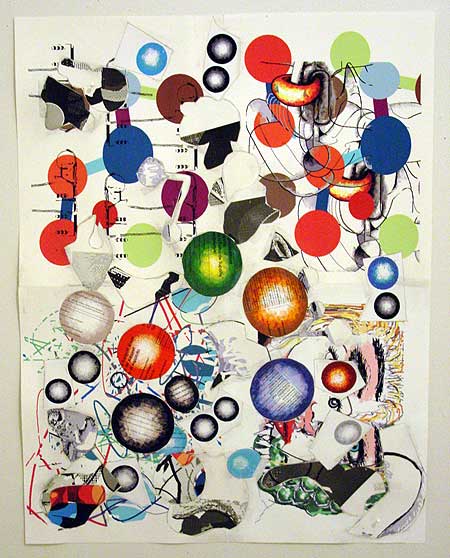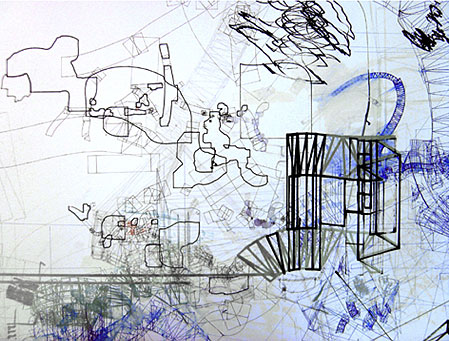
paper, ink, linen tape, 22 x 17 inches
The House Next Door on the '90s anime series Neon Genesis Evangelion:
As Wikipedia reports, GAINAX was, at the time, not a wealthy production studio. Evangelion was begun after a film project was dropped due to lack of money and the studio was dropping various parts of their business to stay afloat. The complicated mech designs of the Eva series were originally deemed to be too complicated for merchandising, the accompanying manga was initially viewed poorly, and funding sources pulled out one after another while the series aired. As the show became too expensive to animate from episode to episode, more and more earlier footage was re-used. This should have been a disastrous choice, but the way the re-used footage was incorporated into the internal struggle episodes is a large part of what has made Evangelion so memorable.
For what it's worth this blog assumed back in the day that the long pregnant pauses between tortured, painfully communicating characters were completely intentional.
Computer music composer and trailblazer Paul Lansky has given up making electronic music to concentrate on scores for live musicians, per the Times. His acoustic music (such as the Coplandesque "Odd Moments") is superb so this bodes well.
We probably could have done without the digs at his former field in the article ("I basically don’t like electronic music. I like to compose it. I’m just not a big fan of it" and "His conversion, in a sense, is a relinquishing of the need to control, the rejection of what he called an antisocial bent") but there's no denying this part:
In some ways Mr. Lansky’s shift is emblematic of the field’s disintegration, at least from the way it was constructed even a decade ago.
In the early years of making music with computers, it could take days to produce a few measures of music. Composers went to universities and congregated around giant multimillion-dollar mainframes — "big iron" — to create pieces. Mr. Lansky used punch cards to make his first electronic piece, "mild und leise," in 1973. "It was tedious, backbreaking work," he said.
Now a tiny laptop dwarfs the creative power of those behemoths. Electronic composition has left the laboratory. Any Mac user can compose, and much of music making is shot through with digitization. Composers commonly write with computer programs. Electronic music trends now lie in interactive computer programs that create sounds together with live performers or electronically alter acoustic instruments.
Again, all that's true but hardly a reason for quitting. ("Waaah, it's just not backbreaking any more.") The use of "any Mac user" as a synonym for "the boob in the street" is mightily amusing, however.

Lee Arnold finds this nugget (and others) at the SIGGRAPH conference [via the vertexList blog]:
Matt Shlian was at the conference as an artist in residence. He gave a fascinating talk about his intended misuse of technology to create paper sculptures and drawings. The work above was created with a digital plotter printer in which Shlian replaced the original drawing implements with Sharpie, ballpoint pen, and pencil.
Looks good. Would like to know more about the imagery, though. Is appropriated/scanned? Drawn by the artist on the computer? Based on a generative algorithm? The "misuse" of the printing tool is great, but one wonders if that same philosophy of misuse extends to the creation of the imagery somehow. Are the various low-tech writing implements causing the drawing to fail in some way (i.e., be imperfect or incomplete)? These look like contour drawings of architecture made with eyes closed--are they? The "timbres" are nice, balancing the machine- and handmade, but it would also be nice to know that it's not just an illustrational "look" that a web startup could use to make its style more "grunge." Is it possible to make bad (non-tasty) drawings with this method?
The lawyers are fighting about Watchmen rights, per the New York Times.
Meanwhile, Alan Moore, who wrote the comic and sold the film rights years ago, remains characteristically caustic. From IMDb:
When asked in an interview with ReelzChannel.com about original Watchmen writer Alan Moore's dismissal of his movie, [director Zack] Snyder was quoted as saying "Worst case scenario - Alan puts the movie on his DVD player on a cold Sunday in London and watches and says, 'Yeah, that doesn't suck too bad.'" When this was brought up with Moore himself in a later interview in the British Tripwire comics fanzine, the writer commented "That's the worst case scenario? I think he's underestimated what the worst case scenario would be... that's never going to happen in my DVD player in 'London' [Moore very famously lives in Northampton]. I'm never going to watch this fucking thing."
The Times has a photo of Nite Owl and Silk Spectre II busting Rorschach out of the hoosegow. SSII looks more "whorey" than in the comic. Her short skirt and "neckline plunging to the navel" have been traded for Aeon Fluxy garters and thigh-high black boots. Nite Owl is supposed to be a slightly paunchy middle aged man--here he is younger and more musclebound. I'm sure Moore will be right, as he was about the V for Vendetta movie. To make it work at all it won't be the Watchmen that was so riveting in the '80s.